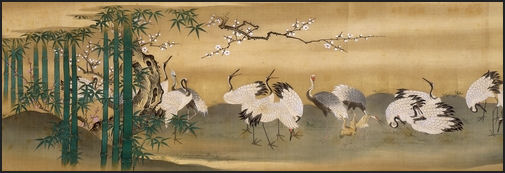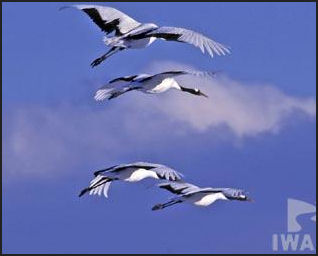Cranes are symbols of love, happiness, martial fidelity and longevity in east Asia. They are common motifs on kimonos, scrolls, screens, porcelain, lacquerware, bronze mirrors and a popular brand of playing cards. Cranes also appear in Russian folk songs, ancient Egyptian tombs, Greek myths, Australian aboriginal dances, and prehistoric European cave art.
Jennifer Ackerman wrote in National Geographic, “The Japanese have written the tancho into poems and folktales and myths. They have painted it and made statues and sculptures to it...From its habits they have drawn phrases and metaphors to describe their own behavior. They have imitated it and tried to dance as it dances. They have named streets and cities after it. They have folded it into tiny birds of paper and hung them carefully in colored festoons at temples and shrines...Most of all they. They have made I into an icon and put its image everywhere, so this extremely rare bird is, ironically, seen throughout Japan."
The 17th century Japanese poet Basho wrote the following haiku:
Cool seascape with cranes
Wading long-legged in the pools
Amid the tideway dunes.
Cranes are the tallest and arguably the most elegant of all flying birds. More closely related to rails and bustards than herons, ibises and storks, they are known best for their unwavering faithfulness to mates, spectacular courtship displays, large size, long migrations and loud calls. Many species can reach a height of five feet within a year after they are born. Some of them have long life spans. One Siberian crane is known to have lived for 83 years.

 There are 15 species of crane. They generally make their homes in grasslands and wetlands. Nine species of crane are endangered. Some are near extinction. Their numbers have been reduced by hunting and habitat loss. Captive breeding programs have been set up in several countries to increase their numbers. At some of these places, cranes are raised by humans in crane costumes and taught to fly over grass runways with the help of ultralight planes flown by men in crane costumes.
There are 15 species of crane. They generally make their homes in grasslands and wetlands. Nine species of crane are endangered. Some are near extinction. Their numbers have been reduced by hunting and habitat loss. Captive breeding programs have been set up in several countries to increase their numbers. At some of these places, cranes are raised by humans in crane costumes and taught to fly over grass runways with the help of ultralight planes flown by men in crane costumes.  Crane pairs establish large breeding territories in wetlands and grasslands and zealously defend them. Intruders are warned off with a loud trumpeting. A pair builds a platform nest in shallow water. Typically two eggs are laid, with both sexes sharing incubation duties. After they hatch chicks remain with their parents until the next breeding season. In many cases only one chick survives. The low reproductive makes rebuilding decimated crane population a difficult task.
Crane pairs establish large breeding territories in wetlands and grasslands and zealously defend them. Intruders are warned off with a loud trumpeting. A pair builds a platform nest in shallow water. Typically two eggs are laid, with both sexes sharing incubation duties. After they hatch chicks remain with their parents until the next breeding season. In many cases only one chick survives. The low reproductive makes rebuilding decimated crane population a difficult task.
Migrating Cranes

 Some cranes in northern areas migrate thousands of kilometers between breeding and wintering areas. Unlike many other birds cranes are not born with the instinct to fly their migrations paths. Young are taught the route when they accompany their parents on the migration.
Some cranes in northern areas migrate thousands of kilometers between breeding and wintering areas. Unlike many other birds cranes are not born with the instinct to fly their migrations paths. Young are taught the route when they accompany their parents on the migration.  The distance covered by some migrating cranes is between a 1,000 miles and 3,000 miles. The fly over deserts, tundra and mountain ranges and rely on wetlands along the way to rest and replenish themselves. Cranes can sustain speeds of 30 mph by flying with flapping wings. They prefer to save energy by rising in n thermals and being carried by winds.
The distance covered by some migrating cranes is between a 1,000 miles and 3,000 miles. The fly over deserts, tundra and mountain ranges and rely on wetlands along the way to rest and replenish themselves. Cranes can sustain speeds of 30 mph by flying with flapping wings. They prefer to save energy by rising in n thermals and being carried by winds.  Some cranes know its time to breed based on seasonal markers such as day length and rainfall amounts. Demoiselle cranes can reach altitudes of 24,000 feet when they cross the Hindu Kush during their fall and spring migrations between nesting grounds in Central Asia and warmer, wintering areas in India.
Some cranes know its time to breed based on seasonal markers such as day length and rainfall amounts. Demoiselle cranes can reach altitudes of 24,000 feet when they cross the Hindu Kush during their fall and spring migrations between nesting grounds in Central Asia and warmer, wintering areas in India. Whopping cranes and Siberian cranes brought up in captive breeding programs are being taught to migrate by humans with ultra lights and hand gliders.
Whopping cranes and Siberian cranes brought up in captive breeding programs are being taught to migrate by humans with ultra lights and hand gliders.
Image Sources: 1) 2) British Museum 3) 4)Wolfgang Kaeler, International Wildlife Adventures 5) Hubpages blog 6) Nicolas Delerue 7) Japan-Animals blog
Text Sources: New York Times, Washington Post, Los Angeles Times, Daily Yomiuri, Times of London, Japan National Tourist Organization (JNTO), National Geographic, The New Yorker, Time, Newsweek, Reuters, AP, Lonely Planet Guides, Compton’s Encyclopedia and various books and other publications.
No comments:
Post a Comment